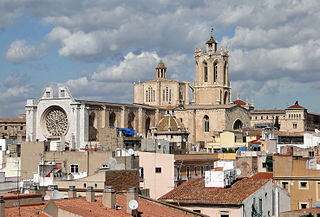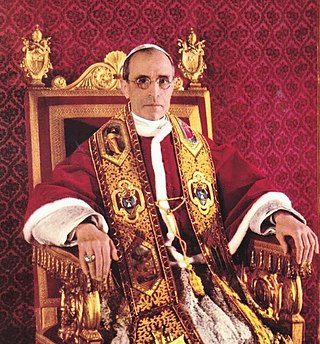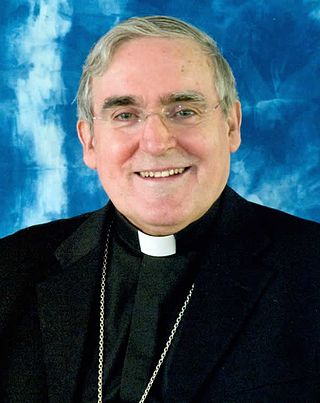
Pope Siricius was the bishop of Rome from December 384 to his death. In response to inquiries from Bishop Himerius of Tarragona, Siricius issued the Directa decretal, containing decrees of baptism, church discipline and other matters. His are the oldest completely preserved papal decretals. He is sometimes said to have been the first bishop of Rome to call himself pope.
The hierarchy of the Catholic Church consists of its bishops, priests, and deacons. In the ecclesiological sense of the term, "hierarchy" strictly means the "holy ordering" of the church, the Body of Christ, so to respect the diversity of gifts and ministries necessary for genuine unity.

The sacraments of initiation are the three sacraments of Baptism, Confirmation, and Eucharist in Nicene Christianity. As such, they are distinguished from the sacraments of healing and from the sacraments of service.

The Archdiocese of Tarragona is a Latin Church ecclesiastical territory located in north-eastern Spain, in the province of Tarragona, part of the autonomous community of Catalonia. The archdiocese heads the ecclesiastical province of Tarragona, having Metropolitan authority over the suffragan dioceses of Girona, Lleida, Solsona, Tortosa, Urgell and Vic.

The Directa decretal was written by Pope Siricius in February AD 385. It took the form of a long letter to Spanish bishop Himerius of Tarragona replying to the bishop’s requests for directa on various subjects sent several months earlier to Pope Damasus I. It became the first of a series of documents published by the Magisterium that claimed apostolic origin for clerical celibacy and reminded ministers of the altar of the perpetual continence required of them.

The Diocese of Galway, Kilmacduagh and Kilfenora is a Latin Church diocese of the Catholic Church in the west of Ireland. It is in the ecclesiastical province of Tuam and is subject to the Metropolitan Archdiocese of Tuam. The deanery of Kilfenora, previously a diocese in its own right, lies in the ecclesiastical province of Cashel. The ordinary is Bishop Michael Duignan who was appointed on 11 February 2022.

The priesthood is the office of the ministers of religion, who have been commissioned ("ordained") with the Holy orders of the Catholic Church. Technically, bishops are a priestly order as well; however, in layman's terms priest refers only to presbyters and pastors. The church's doctrine also sometimes refers to all baptised (lay) members as the "common priesthood", which can be confused with the ministerial priesthood of the consecrated clergy.
The Section for Relations with States or Second Section of the Secretariat of State is the body within the Roman Curia charged with dealing with matters that involve relations with civil governments. It has been part of the Vatican Secretariat of State since 1909.

The Archdiocese of Barcelona is a Latin metropolitan archbishopric of the Catholic Church in northeastern Spain's Catalonia region.

The cardinal electors in the 1963 papal conclave numbered 82, of whom 80 participated. This papal conclave met from 19 to 21 June 1963. This list is arranged by region and within each alphabetically.

The cardinal electors in the 1939 papal conclave numbered 62 and all of them participated. They are arranged by region, and within each alphabetically.

Manuel Arce y Ochotorena was a Spanish Cardinal of the Roman Catholic Church who served as Archbishop of Tarragona from 1944 until his death, and was elevated to the cardinalate in 1946 by Pope Pius XII.

Isidro Gomá y Tomás was the Bishop of Tarazona in the province of Zaragoza known for his strong support of Francisco Franco and the National Movement during the Spanish Civil War from 1936 to 1939. He was also later made Cardinal and Archbishop of Toledo and was Primate of Spain. Gomá was an integrista, in the technical sense in believing in the necessity of a 'Confessional State' that imposes upon all its subjects the profession and practice of the Roman Catholic religion and prohibits all others.

Lluís Martínez i Sistach is a Spanish prelate of the Catholic Church. He is Archbishop emeritus of Barcelona, having served as archbishop there from 2004 to 2015. He has been a cardinal since 2007.

The 53 cardinal electors in the 1922 papal conclave are listed by region, and within each alphabetically by country. Seven out of the sixty electors did not participate, three for reasons of health: José María Martín de Herrera y de la Iglesia, Giuseppe Antonio Ermenegildo Prisco, and Lev Skrbenský z Hříště. Joaquim Arcoverde de Albuquerque Cavalcanti of São Sebastião do Rio de Janeiro knew he could not reach Rome in time for the conclave and did not attempt the journey. The other three non-European cardinals–William Henry O'Connell of Boston, Denis Dougherty of Philadelphia, and Louis-Nazaire Bégin of Québec City–did not arrive in time to participate in the conclave. Within a month of his election, Pope Pius XI lengthened the waiting period before the start of a papal conclave to allow cardinals from distant places to participate in the balloting.

Francisco de Asís Vidal y Barraquer was a Spanish Catalan cardinal of the Roman Catholic Church who served as Archbishop of Tarragona from 1919 until his death; he was elevated to the rank of cardinal in 1921.
The historical roots of Papal primacy can be traced back to the early centuries of Christianity, wherein the bishop of Rome, commonly referred to as the Pope, gradually accrued increasing authority and recognition. A confluence of historical, theological, and political factors contributed to this development.
A decretum laudis is the official measure with which the Holy See grants to institutes of consecrated life and societies of apostolic life the recognition of ecclesiastical institution of pontifical right. When the decree of praise is issued in the form of an apostolic brief, it is referred to as a 'brief of praise'.













